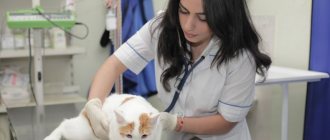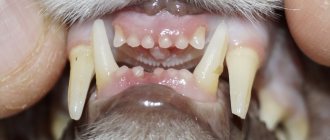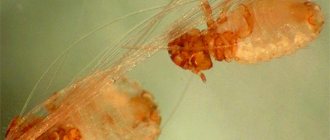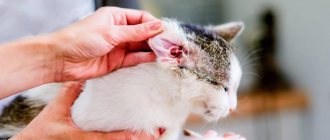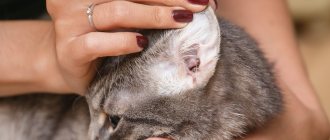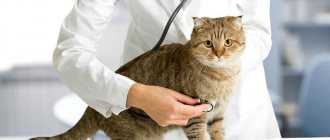Before talking about liver disease in cats, pet owners should have an idea of its role and the function that the liver performs in the cat's body.
Due to its diverse and complex functions in the body, the liver is simultaneously an organ of digestion, circulation and metabolism.
It is located in the anterior part of the abdominal cavity, lies directly behind the diaphragm, mostly in the area of the right hypochondrium.
The liver in the animal’s body plays a very important role in metabolism, participating in the exchange of carbohydrates, fats, proteins, vitamins, microelements and water.
The liver neutralizes toxic substances that enter it from the intestines. The liver maintains normal blood sugar levels; glycogen is deposited and broken down in the liver. In lactating cats, many milk precursors are synthesized in the liver.
In the process of fat metabolism, phosphatides are synthesized in the liver, which subsequently enter the blood. The body's proteins are synthesized from amino acids carried through the bloodstream to the liver. The liver is a blood depot; up to 10% of a cat's total blood is in the liver.
During the process of transamination in the liver, the amount of amino acids contained in excess in the body decreases and the missing ones increase. The liver in animals is a reserve “depot” of proteins. Blood plasma proteins (albumin, globulins, fibrinogen, prothrombin) are formed in the liver, from where they enter the blood. Protein renewal occurs in the liver. The liver stores vitamins “A” and “D”, microelements – iron, copper, manganese, zinc. The liver breaks down hormones such as thyroxine, insulin, ACTH, vasopressin, and sex hormones.
A specific function of the liver is bile formation.
The liver has an incredible ability to regenerate. Up to 75% of all hepatocytes (liver cells) work in the liver at the same time, so the liver always has reserves. Even in the case of severe liver damage by some kind of poison, if the cat still has at least a small number of healthy cells, the doctor has a chance for a successful outcome of this or that disease.
Main symptoms of liver disease in cats.
Liver disease in cats is characterized by a number of signs that should alert its owner. An owner can suspect liver disease in their cat based on the following symptoms:
- Vomiting in a cat.
- Cat has diarrhea.
- Jaundice, in which icteric staining of the mucous membranes and subcutaneous tissue occurs in a yellow color.
- Skin itching.
- Change in urine color, from yellow to brown.
- Change in color of feces from brown to gray or brown.
- Abdominal dropsy, ascites – an increase in the volume of the abdomen due to the accumulation of fluid in the abdominal cavity.
- An increase in the size of the liver, which manifests itself as a protrusion through the abdominal wall.
- Pain in the liver area (hepatic colic).
- Multiple hemorrhages in the skin and subcutaneous tissue.
- Poor blood clotting.
Major liver diseases in cats.
Hepatitis is the general name for inflammatory diseases of the liver tissue. Hepatitis often occurs simultaneously with diseases of the stomach, intestines, pancreas and other organs. With hepatitis, the gallbladder and bile ducts are almost always involved in the process. Hepatitis is accompanied by profound disturbances in protein, carbohydrate-fat and pigment metabolism, and liver cells disintegrate.
In its course, hepatitis can be acute or chronic.
Etiology. Hepatitis in cats rarely occurs as an independent disease and is usually a secondary manifestation of various infectious, invasive diseases and intoxication with poisons of plant and mineral origin. The development of hepatitis is facilitated by reduced resistance of the cat’s body, functional weakening of the liver due to congestion in the venous system.
Clinical signs. When conducting a clinical examination of a sick cat, a veterinarian finds jaundice, an icteric yellow discoloration of the visible mucous membranes, conjunctiva and skin. In some sick cats, owners report loss of appetite, increased thirst, increased body temperature, and symptoms of diarrhea or constipation. Fecal matter is grayish-yellow in color, urine color changes from yellow to dark yellow. In severe cases of hepatitis, the cat experiences convulsions.
A veterinarian makes a diagnosis of hepatitis based on clinical signs of the disease and laboratory testing of blood and urine for bilirubin.
Treatment. Treatment of hepatitis in a cat depends on the cause that caused its development. A sick cat is prescribed a diet that does not contain fatty foods. On the first day of treatment, the cat is put on a starvation diet, after which it is switched to feeding porridge; after a week, minced meat is gradually introduced into the feeding diet. Among the medications, the cat is prescribed B vitamins and preparations containing choline (Essentiale, etc.). To reduce pain and eliminate congestion in the liver, antispasmodics are used. Aminazine and fosprenil are used to relieve acute conditions in liver failure. If there are signs of dehydration, a saline drip. To relieve intoxication, injections of glucose with vitamin C. To eliminate an allergic reaction, antihistamines. Conducting antibiotic therapy. For hepatitis, herbal infusions are taken, which have a diuretic and choleretic effect.
Functions of the liver in the body
Liver tissue is unique in its structure; it is this feature of the architectonics of liver tissue that allows it to perform the following functions in the body:
- Removing toxic compounds from the body. The universal system of oxidative enzymes promotes the transformation of poisons and toxins into insoluble substances and their rapid elimination through the intestines.
- Participation in the formation of blood components. The liver synthesizes most of the blood coagulation factors that maintain homeostasis balance.
- The secretion of bile, which has a bactericidal effect, breaks down fats into smaller fractions, promoting digestion.
The synthesis of protein and protein fractions also occurs only thanks to the liver tissue. Therefore, when an organ is damaged, the functioning of the immune system first decreases (all known antibodies are proteins in nature).
How does the liver work?
The liver is the largest gland of the body, the main task of which is to neutralize and remove poisons from the body (including metabolic products), excess hormones, mediators, and vitamins. To do this she:
- filters out fat-soluble toxins, turning them into water-soluble substances;
- produces enzymes that break down drugs and other chemical compounds.
The more poisons in the body, the heavier the liver. Toxins kill her cells (hepatocytes), and regeneration takes time. While the new cell grows, the load on nearby tissues increases.
If there are too many poisons, hepatocytes can die en masse, then connective tissue appears in their place. Although it closes the hole, it is unable to perform the work of the liver. Intoxication of the body begins, which can cause death.
Other liver functions
Neutralization of poisons is the main, but not the only task of the liver. She:
- Participates in lipid and carbohydrate metabolism.
- Produces proteins, incl. albumins, which carry hormones and other substances to cells.
- Stores minerals, glycogen, triglycerides.
- Activates vitamins.
- Synthesizes substances that are involved in blood clotting.
- Produces bile acids and enzymes.
The liver processes bilirubin, a pigment formed after the breakdown of red blood cells. This is a very toxic substance, which the organ neutralizes and sends as part of bile to digest food. The pigment then passes into the stool and leaves the body.
Excess bilirubin in the blood is the cause of yellowing of the mucous membranes in animals. The pigment is sent not into the bile, but into the plasma, so the stool, to which it gives a dark color, becomes discolored. The urine becomes the color of beer because the bilirubin has to be excreted by the kidneys.
Causes of liver diseases
The list of etiological factors that can damage liver tissue is quite extensive:
- Abdominal injuries in cats, for example, from a fall from a very high height, an accident or a deliberate blow. Rupture of the liver capsule leads to bleeding and an immediate decrease in the functional capacity of the organ.
- Infectious diseases, for example, viral and toxic hepatitis, are common among many members of the cat family.
- Oncological diseases in which a disintegrating tumor leads to direct tissue damage and also causes significant intoxication of the body.
- A particularly important role belongs to helminths and parasites, whose favorite localization is the hepatic bile ducts. By blocking the flow of bile, parasites lead to damage to liver tissue.
The final stage of any liver destruction is cirrhosis, in which the unique structure of the liver parenchyma is completely or partially replaced by connecting adhesions.
Signs of acute hepatitis
Acute hepatitis can be caused by an infectious or toxic agent. Not only salts of heavy metals, food and chemical poisons, but also metabolites of the body’s own often act as toxins. A similar situation occurs in cats suffering from diabetes, hyperthyroidism, and renal failure.
The main signs of the development of acute inflammation of the liver tissue include:
- Changing your pet's behavior and activity.
- Increased body temperature.
- The appearance of vomiting and diarrhea.
With a massive lesion, jaundice quickly follows, which can be seen on the sclera and areas of skin with minimal fur.
With a detailed examination, you can detect signs of toxic shock: increased heart rate and at the same time low filling. With toxic damage to the brain, seizures occur.
Chronic hepatitis clinic
The most common form of liver tissue damage is chronic hepatitis. This form of pathology develops more slowly, but has no less serious consequences.
Depending on the violation of one or another organ function, the following signs of liver disease in cats may be observed:
- Gradual weight loss of the animal.
- Changes in appetite and food preferences.
- The shine of the coat disappears, and the skin under the coat takes on an unhealthy tint.
- A specific odor may appear if detoxification processes are disrupted.
- Jaundice is a constant companion of all cirrhosis, in which the passage of bile is disrupted.
- Digestive disorders certainly appear, the consistency of stool changes, as well as its color (discoloration).
In the later stages of liver cirrhosis, an increase in the abdomen is observed against the background of general weight loss. This symptom is associated with the development of swelling of soft tissues, and difficulty in moving blood through the venous bed.
Diagnostic measures
Diagnosis of feline hepatoencephalopathy consists of a general clinical examination of the patient, as well as a biochemical blood test. For more detailed information about the condition of the animal, a special test for the content of bile acids and a general analysis of urine is performed.
It is important to note that the bile acid test is performed several times, usually on an empty stomach and after meals. With hepatic encephalopathy, the content of bile acids increases or remains within normal limits in a hungry animal and increases sharply (9 times) after eating.
A biochemical blood test can determine a decrease in protein (albumin), moderate urea content and a reduced total cholesterol level. When analyzing urine, ammonium biurate crystals are diagnosed, which subsequently form stones. In addition, radiographic studies are carried out to identify changes in the size of the liver structures, ultrasound diagnostics to determine the presence of abnormal choroid plexuses in the liver and disturbances in blood flow in the organ.
Magnetic resonance imaging makes it possible to identify portosystemic shunts, and liver biopsy makes it possible to assess the condition of the tissues and identify the root cause of the pathological process.
During diagnosis, it is important to carry out differential diagnosis. Thus, the clinical signs of hepatic encephalopathy are similar to hypoglycemia, hyperosmotic diabetes mellitus, uremia due to renal failure, acidosis and enzyme defects in the urea cycle (liver dysfunction).
In addition, it is necessary to distinguish hepatoencephalopathy from disorders of the endocrine system, brain tumors, infectious and inflammatory processes in the central brain. The clinical picture of hepatic encephalopathy is similar to granulomatous meningoencephalitis, traumatic pathologies of the central nervous system and congenital anomalies of the brain.
Liver helminthiasis clinic
Helminths simply love to parasitize the hepatic bile ducts. For this reason, the disease occurs as a type of biliary tract obstruction.
The following symptoms of liver disease in cats are observed:
- Jaundice appears.
- Very often, due to intoxication, repeated vomiting develops.
- A white chair appears.
The parasites themselves are powerful provocateurs for the pet’s immune system.
For this reason, frequent companions of the pathology are fever and general intoxication (weakness, the animal stops getting up, moving, eating). Pain indicates the direct toxic effect of parasites.
Macro- and microscopic structure of liver tumors
Liver tumors, according to the WHO tumor classification, are divided into:
- A. Epithelial benign: hepatocellular adenoma, adenoma of the intrahepatic bile ducts, cystadenoma of the intrahepatic bile ducts.
B. Epithelial malignant: hepatocellular cancer, cholangiocarcinoma, bile duct cystadenocarcinoma, mixed hepatocholangiocellular cancer, hepatoblastoma, undifferentiated cancer.
- Non-epithelial tumors: hemangioma, infantile hemangioendothelioma, hemangiosarcoma, embryonal sarcoma, etc.
- Various other types of tumors: teratoma, carcinosarcoma, etc.
- Unclassified tumors.
- Tumors of hematopoietic and lymphoid tissues.
- Metastatic tumors
In table 2 and 3 present our results of a morphological study of primary and metastatic liver lesions in dogs and cats undergoing surgical treatment
Table 2 Morphological types of primary liver tumors in dogs and cats (n=23)
| Primary liver tumor | Dog | Cat |
| Hepatocellular cancer | 12 (52.1%) | |
| Cholangiocellular carcinoma | 2 (8.7%) | |
| Hemangioma | 4 (17.4%) | 3 (13.04%) |
| Fibrosarcoma | 1 (4.3%) | |
| Combined tumors | 1 (4.3%) |
Table 3 Morphological types of metastatic liver lesions in dogs and cats (n=21)
| Metastasis to the liver from | Dog | Cat |
| Breast cancer | 9 (42.9%) | 2 (9.5%) |
| Ovarian cancer | 5 (23.8%) | |
| Cancer of the body of the uterus | 1 (4.8%) | |
| Kidney cancer | 1 (4.8%) | |
| Soft tissue sarcomas | 2 (9.5%) | |
| Fibrosarcomas of the spleen | 1 (4.8%) |
Analysis of the table shows that among primary liver tumors, hepatocellular cancer is the most common, which coincides with the data of the international veterinary literature. Metastases of breast cancer prevail over metastases from other organs. This is likely due to the large number of animals suffering from mammary tumors.
Diagnosis of liver diseases
An important point in any diagnosis of liver pathology is ultrasound examination. On the ultrasound screen, you can visually detect the body of the helminth, a congenital bend of the bile duct, a tumor or a stone that disrupts the passage of bile.
Also in practice, additional research methods are used:
- A general blood and urine test can reveal signs of acute infection.
- A biochemical blood test may show an increase in liver enzymes, signs of concomitant kidney pathology (for example, with simultaneous damage to the kidneys and liver).
- Detection of bile fractions in the urine is a sign of impaired bile outflow.
Also, the veterinarian must study all the symptoms over time, assessing the effect of the therapy received.
Morphological study
For diagnosis and differential diagnosis in veterinary practice, cytological and histological studies are carried out.
To obtain material for the purpose of cytological examination, a Spinocan 25 Gx spinal needle is used. Biopsies for histological analysis are obtained using a tru-cut needle.
The most common complication of liver biopsy is bleeding. Of the 32 biopsies performed in our clinic using the needles described above, we did not receive a single serious case.
The most effective for making a diagnosis is the complex: “X-ray examination + ultrasound + detailed laboratory diagnostics + puncture biopsy of the liver.” Moreover, laboratory diagnostics should be carried out to the fullest extent possible, especially if surgical intervention is planned, because this allows you to minimize the risk of postoperative complications, as well as determine the prognosis. Also, one should not neglect such a modern diagnostic method as intraoperative ultrasound, which reveals invisible and non-palpable liver tumors, and also allows, in difficult cases, to determine the location of large vessels, which greatly facilitates the operation and minimizes the risk of bleeding.
Treatment of liver diseases
Due to the complex organization of liver tissue and the large number of functions performed, close attention is paid to the treatment of liver diseases in cats.
Basic therapy when symptoms appear is:
- Treatment regimen for a cat.
- Nutrition. There is a rational diet that allows you to eliminate the lipid load on the liver, but at the same time increase protein intake. Replenishing protein deficiency is a key point for the treatment of liver tissue diseases. The owner should carefully read the information on what to feed a cat with liver disease (rice and oatmeal, boiled sea fish, rabbit meat or beef, boiled or baked vegetables). Leading companies have developed special foods for cats with liver diseases.
- For viral and bacterial diseases, an extensive group of antiviral and antibacterial agents is provided (mainly interferon preparations).
- Steroid hormones used as systemic therapy can stop the immune inflammatory process.
- With massive cirrhosis of the liver, it will not be possible to restore the damaged tissue, so the doctor’s task is to organize the correct regimen for the animal.
To maintain lost organ functions, vitamin K preparations and complexes of water-soluble vitamins and minerals are administered.
Antioxidants should be used, due to the fact that the liver cannot perform the function of transforming toxins.
With the development of obstruction of the bile ducts, surgical assistance is resorted to, restoring the normal passage of bile.
Bibliography.
- Vilkovysky I.F. Diagnosis and treatment of liver tumors, Russian Veterinary Journal, No. 1, 2006, pp. 14-17
- Vilkovysky I.F., Solovyeva O.V., Kusenkov S.A. Cryodestruction of tumor lesions of the liver in dogs, Russian Veterinary Journal, No. 1, 2009, pp. 6-10
- Vilkovysky I.F., Lisitskaya K.V., Telitsyn V.V., Krivova Yu.V., Kurinnova S.V. Possibilities of modern methods for diagnosing liver tumors in small domestic animals, Russian Veterinary Journal, No. 1, 2006, pp. 14-17
- Patyutko Yu.I. Surgical treatment of malignant liver tumors, Practical Medicine, 2005
- Matrin RA et all, Liver and billiary system in dogs and cats, Textbooks of small animal surgery, edition 3, Philadelphia, 2003
- Jane M. Dobson Canine and feline oncology, second edition, BSAVA, 2003
- John M.Williams Canine and feline abdominal surgery, BSAVA, 2005
- Withrow S, et all, Small animal clinical oncology, fourth edition, Canada, 2007
